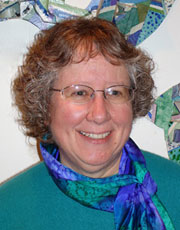Assessing innovative intervention for children with cerebral palsy
Five-year-old Lauren’s cerebral palsy used to make eating meals an ordeal, going to bed a challenge, and crawling an impossibility.
But her new baclofen pump implant helps loosen and tone her muscles, making daily activities much easier to manage for Lauren and her family.
“She can crawl upstairs now, allowing my 71-year-old mother… to be able to safely get Lauren upstairs and to bed,” says Lauren’s mother, Sandy Tierney. “She sleeps better, naps less and is happier now that her body is more predictable and responds to her.”

Benedict
Lauren and her parents have been participating in occupational therapy professor Ruth Benedict’s ongoing study to measure the functional effects of the baclofen pump for children with cerebral palsy (CP).
Compared to injections and pills that wore off or caused fatigue, the pump’s slow and measured release of baclofen — a drug derived from a mammalian neurotransmitter acid — gives Lauren the consistent muscle tone she needs to go about her life more comfortably and quickly.
“I don’t have to take the pill any more, and then I can have breakfast quicker,” Lauren says, as relayed by her mother. “It helps me get up the stairs more easily, and I’m not so tight.”
Benedict is studying how the pump and subsequent therapies affect functioning, care, health, well being and participation in home and community life for clients with CP as well as their caregivers.
Health care providers are putting a lot of resources into supporting children who receive these interventions, so knowing that it is effective is imperative, Benedict says.
“Certainly there’s enough evidence out there right now to show that it is effective enough in terms of reducing (muscle) tone in these children, but there’s not enough evidence out there showing what the implications are for care giving, and for the child’s function,” she says. “That’s what we’re hoping to show — that not only is there a physiological change in the child, but that the physiological change has implications for the child’s function and for the caregivers ability to care for the child.”
Benedict’s research team has already collected pre-intervention data on 20 client-caregiver pairs, six-month post-surgery data on more than half the pairs, and two-year data on five pairs.
Participants fill out initial questionnaires about their health, activities and spasticity management and other effects of cerebral palsy on their daily activities. They meet with the research team a total of four times, once before and three times after the surgery. Team members interview participants about their goals and concerns regarding the treatment and record them as they perform typical activities while wearing equipment that monitors their movements and energy exertion.
“Thus far, the general perception is that there does seem to be a change, at least in some areas of care giving, but we’ll have to wait until we see and analyze all the data to know for sure,” she says.
CP is one of the most prevalent childhood disabilities, and an expensive one — a 2003 CDC report estimates that the cost during one person’s lifetime can be more than $900,000.
Benedict hopes to show that the functional benefits of the pump, including caregiver time and energy, outweigh its side effects and financial cost, she says.
She also expects to prove what Tierney hopes for — that the pump will allow Lauren and other children with CP to get a much better return from life-long therapy with occupational therapists and other health care professionals.
“I strongly believe that if we want access to these knowledgeable and highly skilled professionals, we need to help in the information learning and training process,” Tierney says. “Participating in research is for our benefit as well as others.”


